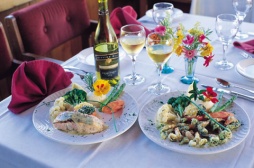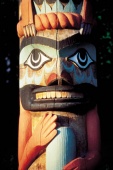
|
|||||||||||||||||||||||||

|
|||||||||||||||||||||||||
British Columbia, Canada
|

|
||||||||||||||||||||||||
The pacific coast is lined with many rain forests that are unique in this kind. British Columbia has all climate zones - from glaciers in the mountain ranges, to rain forest on the coast and moderate climate in the interior, up to the desert zones in the southern parts, where even the cactus find its home. Besides cosmopolitan cities such as Vancouver and Victoria British Columbia offers an incomparable nature that is partly still untouched. This is where vacation dreams come from. No wonder why so many visitors are mad about this province and many of them even consider immigration. British Columbia in Figures British Columbia is Canada's third largest province and covers an area of 948,596 sq km. This is about 10 per cent of Canada and is as big as the area of Germany, Austria, France, The Netherlands, and Belgium combined. Just the area covered by fresh water is with 95 million hectares as large as Germany and France together. There are 4.023.000 people who call British Columbia their home (July 1999). The top ten languages spoken in British Columbia are: English, Chinese (Cantonese/Mandarin), Punjabi, German, French, Italian, Tagalog, Spanish, and Japanese (1996). There are 197 bands of First Nations in British Columbia such as Gitxsan, Haida, Nisga'a and Squamish. More than 675 parks and protected areas in British Columbia attract about 24 million visitors from all over the world annually. About 35,000 immigrants from many different countries find a new home in British Columbia each year. Fairweather Mountain on the Alaska border is British Columbia's highest mountain and measures 4,663 meters.
Vancouver with its 2 million habitants is the largest city of BC, followed by Victoria (330,000) and Kelowna (150,000). British Columbia can be traveled year round, however the peak season is in the months of July and August. Arrival The most common way to British Columbia is via Vancouver by plane. In the summer months there are daily non-stop flights from Europe. Flights are offered by Air Canada and Lufthansa as well as by British Airways. British Airways flights generally have a stop over in London. You should compare prices as there are many specials you can benefit from. Swiss Air offers service from Switzerland. Traveling within British Columbia We recommend a rental car or RV as roads are usually in good conditions in the southern part of British Columbia. For those of you, who intend to discover the north of the province should consider renting a 4-wheel drive vehicle as gravel roads are fairly common. This applies also to those individuals who consider exploring the wilderness. However you should make up your mind before signing your rental contract as many vehicles may not be used on unpaved roads. This is especially important for RV renters. For the more adventurous traveler a bus ride with Greyhound might be just what you are looking for. The network is broad and prices are reasonable.
Means of payment Besides the most common credit cards (Visa, Master Card and American Express) you might consider carrying some Traveler's Cheques in Canadian currency and small denominations. Those are generally accepted like cash and have the advantage of being insured. However you should always carry some cash, especially if you intend to push forward to more rural areas. Here cash is the only thing that counts as most of the small shops do not have the equipment to accept credit cards. You should not bring German Marks or American Dollar in order to pay your bills as American Dollars are only accepted near the US border. Prices All prices are generally subject to applicable taxes, which might be uncommon for European travelers. Taxes are added when you pay. Usually you have to pay 14.5 per cent taxes (7 per cent GST Goods and Service Tax and 7.5 per cent Provincial Sales Tax). However some merchandise is tax exempt.
We recommend saving all receipts, as tourists who have their place of residence outside of Canada might be eligible for tax refund. However, this only applies for amounts over CAN $50,00 per receipt (except accommodation receipt where no minimum amount applies) and a minimum of CAN $200,00 in total. Not eligible for tax refund are bills paid for gas or transportation. In any case it might be worthwhile to save receipts for accommodations or larger purchases that are exported. The application for tax refund can be found at the website address shown below. You can file your application up to six months after you have left the country and has to be in writing. A refund cheque will than be mailed to your home address. If you came by plane you are required to send your bording pass with your application. Receipts for goods have to be validated by Canada Customs as you leave Canada. For further information visit Visitor Tax Refund. Opening Hours Usually stores in British Columbia are open 10 am to 6 pm. Some might be open till 9 pm and grocery stores often offer a 24 hour service, which also applies to gas stations who regularly have a convenient store attached. In summer months usually longer opening hours apply. The post office generally closes at 5 pm, banks sometimes already at 4 pm. National Parks and Provincial Parks
Together with the adjoining parks in the Yukon and Alaska the Tasshenshini-Alsek Provincial Park (958.000 hectares) builds the largest World Heritage Site recognized by UNESCO. British Columbia is home to the Glacier, Gwaii Haanas, Kootenay, Mount Revelstoke, Pacific Rim and the Yoho National Park. The most popular Provincial Parks are Mount Robson, Wells Gray, Okanagan Lake and Shuswap Lake Provincial Park. World Heritage Sites British Columbia has following World Heritage Sites: History
The first Europeans arrived in 1778, when Captain James Cook landed on Nootka Island, on the north western coast of Vancouver Island. In 1792 Captain George Vancouver made his way to Nootka with his ships Discovery and Chatham. In the meantime also the Spanish had found their way to Vancouver Island and there were rivalries between England and Spain about Vancouver Island. But already in 1795 the last Spanish ship had been ordered out of the region and made an end to the rivalries and the Spanish influence. After years of arguments with the United States Vancouver Island became an English crown colony in 1849. The first white settlement in British Columbia was founded in 1794 and is nowadays known as Fort St. John. In 1805 the Hudson Bay Company opened its first trading post west of Fort St. John in the northern part of the province. The Hudson Bay Company was a fur trading company who amalgamated with the North West Company in 1821 to the Hudson Bay Company. Along the Fraser River the first gold was discovered in 1858, what lead to a gold rush with thousands of prospectors rushing into the interior. The British government acted quickly and announced their second crown colony British Columbia in 1858. Governor James Douglas, chief factor of the Hudson Bay Company and Governor of Vancouver Island, became the new governor of British Columbia. Both colonies were joined in 1866 and Victoria became the new capital. On July 20, 1871 the province of British Columbia joined the Canadian Confederation. The gold rush continued, when gold in the Peace River region was discovered in 1861. The town of Barkerville developed to a large city during the rush and in its heydays Barkerville was the largest city west of Chicago and north of San Francisco. Billy Barker had set off the rush when he made 1000 dollar within the first two days of his claim. When the Trans Canadian Railway was completed in 1885, British Columbia was connected to the east. During this time there was a big demand for British Columbia's resources - in particular timber - as the settlement within the prairie regions had just begun. In addition the Panama Canal was completed in 1914 and opened the European markets to British Columbia. The economy was booming, but in 1929, when Wall Street crashed, British Columbia was faced with a long lasting recession. With the outbreak of World War 2 the economic recovery started and was sustained after the war with the discovery of new resources and the development of a manufacturing base. Nowadays forestry, mining, fishing and agriculture are important industries for British Columbia. About one half of all employees have found their jobs in small businesses. But also the film and TV production, generating over one billion dollar in 1999 is an important sector for British Columbia's economy. BC is Canada's most attractive film and TV location. 9.2 billion dollars were generated by the tourism industry in 1999 making tourism an important factor for the provincial economy. |
|||||||||||||||||||||||||
|
More Travel Tips for British Columbia
Circle Tours Circle Tour Lower Mainland Circle Tour National Park Hopping BC & AB
Other province's & territories' Travel Tips
|
|||||||||||||||||||||||||







